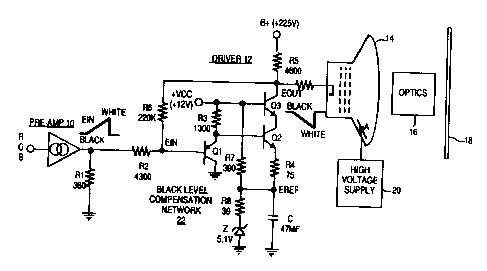Some of the information on this Web page has been provided by external sources. The Government of Canada is not responsible for the accuracy, reliability or currency of the information supplied by external sources. Users wishing to rely upon this information should consult directly with the source of the information. Content provided by external sources is not subject to official languages, privacy and accessibility requirements.
Any discrepancies in the text and image of the Claims and Abstract are due to differing posting times. Text of the Claims and Abstract are posted:
| (12) Patent: | (11) CA 2114880 |
|---|---|
| (54) English Title: | BLACK COMPENSATION CIRCUIT FOR A VIDEO DISPLAY SYSTEM |
| (54) French Title: | CIRCUIT DE CORRECTION DU NIVEAU DU NOIR POUR SYSTEME D'AFFICHAGE VIDEO |
| Status: | Expired and beyond the Period of Reversal |
| (51) International Patent Classification (IPC): |
|
|---|---|
| (72) Inventors : |
|
| (73) Owners : |
|
| (71) Applicants : |
|
| (74) Agent: | CRAIG WILSON AND COMPANY |
| (74) Associate agent: | |
| (45) Issued: | 2003-07-15 |
| (22) Filed Date: | 1994-02-03 |
| (41) Open to Public Inspection: | 1994-08-06 |
| Examination requested: | 2001-01-18 |
| Availability of licence: | N/A |
| Dedicated to the Public: | N/A |
| (25) Language of filing: | English |
| Patent Cooperation Treaty (PCT): | No |
|---|
| (30) Application Priority Data: | ||||||
|---|---|---|---|---|---|---|
|
A driver for a cathode ray tube includes a black level
compensation circuit which generates an offset voltage which
tracks the current flowing to the output of the driver and
therefore the average picture level (APL). The offset voltage is
added as a component of the output voltage so as to increasingly
shift the output voltage toward black as the APL increases. This
compensates for CRT gamma non-linearities and for light
scattering effects which might otherwise cause the loss of
perceived detail and sharpness in dark areas of a high APL image.
In the disclosed embodiment, the driver comprises a cascode
amplifier and the offset voltage generating element includes a
capacitively bypassed resistor connected in a reference voltage
network connected to the emitter circuit of the lower (common
emitter configured) transistor of the cacode amplilfier.
Note: Claims are shown in the official language in which they were submitted.
Note: Descriptions are shown in the official language in which they were submitted.

2024-08-01:As part of the Next Generation Patents (NGP) transition, the Canadian Patents Database (CPD) now contains a more detailed Event History, which replicates the Event Log of our new back-office solution.
Please note that "Inactive:" events refers to events no longer in use in our new back-office solution.
For a clearer understanding of the status of the application/patent presented on this page, the site Disclaimer , as well as the definitions for Patent , Event History , Maintenance Fee and Payment History should be consulted.
| Description | Date |
|---|---|
| Inactive: IPC expired | 2023-01-01 |
| Inactive: IPC expired | 2023-01-01 |
| Inactive: IPC expired | 2023-01-01 |
| Inactive: IPC from MCD | 2006-03-11 |
| Inactive: IPC from MCD | 2006-03-11 |
| Time Limit for Reversal Expired | 2005-02-03 |
| Letter Sent | 2004-02-03 |
| Grant by Issuance | 2003-07-15 |
| Inactive: Cover page published | 2003-07-14 |
| Inactive: Final fee received | 2003-04-24 |
| Pre-grant | 2003-04-24 |
| Letter Sent | 2002-11-13 |
| Notice of Allowance is Issued | 2002-11-13 |
| Notice of Allowance is Issued | 2002-11-13 |
| Inactive: Approved for allowance (AFA) | 2002-10-30 |
| Letter Sent | 2001-02-14 |
| Inactive: Status info is complete as of Log entry date | 2001-02-14 |
| Inactive: Application prosecuted on TS as of Log entry date | 2001-02-14 |
| All Requirements for Examination Determined Compliant | 2001-01-18 |
| Request for Examination Requirements Determined Compliant | 2001-01-18 |
| Amendment Received - Voluntary Amendment | 2001-01-18 |
| Application Published (Open to Public Inspection) | 1994-08-06 |
There is no abandonment history.
The last payment was received on 2003-01-23
Note : If the full payment has not been received on or before the date indicated, a further fee may be required which may be one of the following
Patent fees are adjusted on the 1st of January every year. The amounts above are the current amounts if received by December 31 of the current year.
Please refer to the CIPO
Patent Fees
web page to see all current fee amounts.
| Fee Type | Anniversary Year | Due Date | Paid Date |
|---|---|---|---|
| MF (application, 4th anniv.) - standard | 04 | 1998-02-03 | 1998-01-22 |
| MF (application, 5th anniv.) - standard | 05 | 1999-02-03 | 1999-01-21 |
| MF (application, 6th anniv.) - standard | 06 | 2000-02-03 | 1999-12-23 |
| MF (application, 7th anniv.) - standard | 07 | 2001-02-05 | 2001-01-18 |
| Request for examination - standard | 2001-01-18 | ||
| MF (application, 8th anniv.) - standard | 08 | 2002-02-04 | 2002-01-24 |
| MF (application, 9th anniv.) - standard | 09 | 2003-02-03 | 2003-01-23 |
| Final fee - standard | 2003-04-24 |
Note: Records showing the ownership history in alphabetical order.
| Current Owners on Record |
|---|
| THOMSON CONSUMER ELECTRONICS, INC. |
| Past Owners on Record |
|---|
| CHARLES MICHAEL WHITE |
| THOMAS DAVID GURLEY |